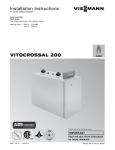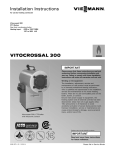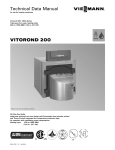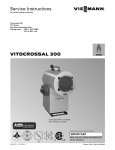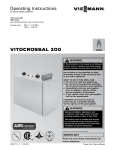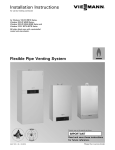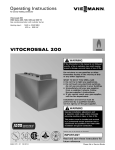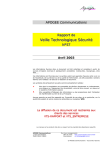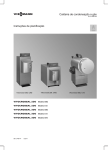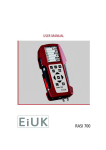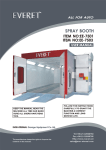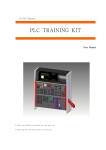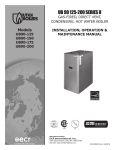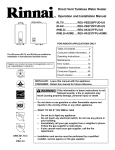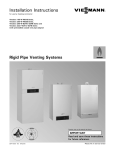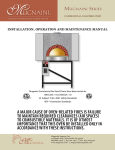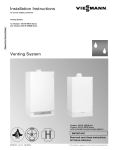Download Viessmann Vitocrossal 620 Technical data
Transcript
Installation Instructions for use by heating contractor Vitocrossal 200 CM2 Series 400, 500, 620 and 620 TX Gas condensing boiler with cylinder burner Heating input: 1445 to 2245 MBH (423 to 658 kW) VITOCROSSAL 200 Product may not be exactly as shown IMPORTANT H 5584 069 - 05 09/2014 Read and save these instructions for future reference. Please file in Service Binder Safety Vitocrossal 200, CM2 400, 500, 620 and 620 TX Installation Safety, Installation and Warranty Requirements Please ensure that these instructions are read and understood before commencing installation. Failure to comply with the instructions listed below and details printed in this manual can cause product/property damage, severe personal injury, and/or loss of life. Ensure all requirements below are understood and fulfilled (including detailed information found in manual subsections). Product documentation Read all applicable documentation before commencing installation. Store documentation near boiler in a readily accessible location for reference in the future by service personnel. For a listing of applicable literature, please see section entitled “Important Regulatory and Safety Requirements”. Warranty Information contained in this and related product documentation must be read and followed. Failure to do so renders the warranty null and void. Licensed professional heating contractor The installation, adjustment, service and maintenance of this equipment must be performed by a licensed professional heating contractor. Please see section entitled “Important Regulatory and Installation Requirements”. For information pertaining to the proper installation, adjustment, service and maintenance of this equipment to avoid formation of carbon monoxide, please see section entitled “Combustion air supply” and “Venting information” in this manual. Contaminated air Air contaminated by chemicals can cause by-products in the combustion process, which are poisonous to inhabitants and destructive to Viessmann equipment. For a listing of chemicals which cannot be stored in or near the boiler room, please see section entitled “Mechanical Room”. in this manual. 2 Advice to owner Once the installation work is complete, the heating contractor must familiarize the system operator/ ultimate owner with all equipment, as well as safety precautions/requirements, shutdown procedure, and the need for professional service annually before the heating season begins. Fresh air This equipment requires fresh air for safe operation and must be installed ensuring provisions for adequate combustion and ventilation air exist. For information pertaining to the fresh air requirements of this product, please see subsection entitled “Mechanical Room” in this manual. Carbon monoxide Improper installation, adjustment, service and/or maintenance can cause flue products to flow into living space. Flue products contain poisonous carbon monoxide gas. Equipment venting Never operate boiler without an installed venting system. An improper venting system can cause carbon monoxide poisoning. For information pertaining to venting and chimney requirements, please see section entitled “Venting Information” in this manual. All products of combustion must be safely vented to the outdoors. WARNING Installers must follow local regulations with respect to installation of carbon monoxide detectors. Follow the Viessmann maintenance schedule of the boiler in the “Service Instructions” manual. 5584 069 - 05 Safety Vitocrossal 200, CM2 400, 500, 620 and 620 TX Installation Safety, Installation and Warranty Requirements Fiberglass wool and ceramic fiber materials WARNING Inhaling of fiberglass wool and/or ceramic fiber materials is a possible cancer hazard. These materials can also cause respiratory, skin and eye irritation. The state of California has listed the airborne fibers of these materials as a possible cancer hazard through inhalation. When handling these materials, special care must be applied. Suppliers of ceramic fiber products recommend the following first aid measures: - Respiratory tract (nose and throat) irritation: If respiratory tract irritation develops, move the person to a dust free location. - Eye irritation: If eyes become irritated, flush immediately with large amounts of lukewarm water for at least 15 minutes. Eyelids should be held away from the eyeball to ensure thorough rinsing. Do not rub eyes. - Skin irritation: If skin becomes irritated, remove soiled clothing. Do not rub or scratch exposed skin. Wash area of contact thoroughly with soap and water. Using a skin cream or lotion after washing may be helpful. - Gastrointestinal irritation: If gastrointestinal tract irritation develops, move the person to a dust free environment. Suppliers of fiberglass wool products recommend the following precautions be taken when handling these materials: - Avoid breathing fiberglass dust and contact with skin and eyes. - Use NIOSH approved dust/mist respirator. - Wear long-sleeved, loose fitting clothing, gloves and eye protection. - Wash work clothes separately from other clothing. Rinse washer thoroughly. - Operations such as sawing, blowing, tear-out and spraying may generate airborne fiber concentration requiring additional protection. (continued) First aid measures - If eye contact occurs, flush eyes with water to remove dust. If symptoms persist, seek medical attention. - If skin contact occurs, wash affected areas gently with soap and warm water after handling. WARNING Appliance materials of construction, products of combustion and the fuel contain alumina, silica, heavy metals, carbon monoxide, nitrogen oxides, aldehydes and/or other toxic or harmful substances which can cause serious injury or loss of life and which are known to the State of California to cause cancer, birth defects and other reproductive harm. Always use proper safety clothing, respirators and equipment when servicing or working nearby the appliance. Codes The installation of this unit shall be in accordance with local codes. In the absence of local codes, use: CAN/CSA-B149.1 or .2 Installation Codes for Gas Burning Appliances for Canada. For U.S. installations, use the National Fuel Gas Code ANSI Z223.1. Always use latest editions of codes. In Canada all electrical wiring is to be done in accordance with the latest edition of CSA C22.1 Part 1 and/or local codes. In the U.S., use the National Electrical Code ANSI/ NFPA 70. The heating contractor must also comply with the Standard for Controls and Safety Devices for Automatically Fired Boilers, ANSI/ASME CSD-1 where required by the authority having jurisdiction. Mechanical room Ensure the mechanical room complies with the requirements of the System Design Guidelines and/or Technical Data Manual. In addition, see section entitled “Mechanical Room” on page 9 in this manual. Viessmann recommends installation of an additional electrical disconnect switch and a fuel shut-off valve (if possible) outside the mechanical room or enclosed area of installation. 5584 069 - 05 The maximum room temperature of the mechanical room where the boiler is located must not exceed 104° F (40° C). 3 Table of Contents Vitocrossal 200, CM2 400, 500, 620 and 620 TX Installation Page General Information Boiler 4 Safety, Installation and Warranty Requirements..............2 Product documentation.............................................2 Warranty................................................................2 Licensed professional heating contractor.....................2 Contaminated air.....................................................2 Advice to owner......................................................2 Carbon monoxide.....................................................2 Fresh air.................................................................2 Equipment venting...................................................2 Fiberglass wool and ceramic fiber material..................3 First aid measures....................................................3 Codes.....................................................................3 Mechanical room.....................................................3 Important Regulatory and Installation Requirements........6 For installations on the Commonwealth of Massachusetts.6 For polypropylene venting systems only....................7 Venting clearance to combustibles (Stainless Steel / Polypropylene)................................7 Working on the equipment.......................................7 Technical literature..................................................7 About these Installation Instructions..............................8 Product Information....................................................8 Mechanical Room.......................................................9 For Retrofit Applications..............................................9 Recommended Minimum Service Clearances. ...............10 Preparing the Boiler...................................................11 Boiler Insulation........................................................12 Boiler Door Insulation................................................12 Boiler Door..............................................................13 Combustion Air Flex Hose.........................................14 Flex Hose Air Intake Adaptor......................................14 Boiler Connections....................................................14 Water side connection...........................................15 Safety Header.......................................................16 Hydrostatic Test Procedure........................................17 Rails and Supports....................................................18 Side Panels.................................................................18 Cross Bar...............................................................19 Mounting the Burner..................................................19 Combustion Air Adapter Burner Connection..................20 Front Side Panels......................................................21 Bottom Plate...........................................................21 Electrical Connections................................................22 Boiler Power Supply..................................................22 Routing Cables.........................................................23 Boiler Water Temperature Sensor and Pipe Coupling Connection.................................................24 Flue Gas Temperature Sensor.....................................24 Condensate Connection.............................................25 Rear Panels..............................................................27 Boiler Control and Junction Box..................................27 Top Panels...............................................................28 Front Panels.............................................................28 Control Panel and Covers...........................................29 Gas Flue Adaptor......................................................29 Gas Connections.........................................................30 Gas Valve Flange Installations.................................30 Valve leak test......................................................31 Boiler Piping in Heating / Cooling Application................32 Initial System Fill......................................................33 5584 069 - 05 Safety Vitocrossal 200, CM2 400, 500, 620 and 620 TX Installation Table of Contents 5584 069 - 05 Page Venting General Venting Information......................................34 Installation steps (outline).......................................34 Recommended venting practice...............................34 Approved venting materials.....................................35 Vent termination location requirements (for installations in Canada).....................................36 Vent termination location requirements (for installations in the U.S.A.)..................................36 Flashing and storm collar installation...........................37 Additional Requirements for Stainless Steel Vent Pipe Material.....................................................37 Exhaust vent/air intake connection to boiler..............37 Requirement for UL/ULC listed Rigid PP Vent Pipe Material...................................................38 Requirements for PP and stainless steel....................38 Vent system suppliers............................................38 Vent Requirements..................................................39 Combustion air supply, room air dependant application only.....................................................39 Direct Venting (Two Pipe System)...............................40 Side wall vent termination (stainless steel, CPVC or PP)...40 Side Wall Venting....................................................41 Side wall vent termination (stainless steel or PP)........41 Component Installation Guide.....................................42 Flashing and storm collar installation........................42 Vent Termination Location Requirements - Vertical.......42 Installation of Support System - PP.............................43 Bracing.................................................................43 Vent system suppliers............................................43 Long Sweep Elbows...............................................43 Standard long sweep elbow equivalent length material...43 Venting Options - Stainless Steel/PP Two Pipe System-Vertical Exhaust/Vertical Air Intake.....44 Two Pipe System-Horizontal Exhaust/Horizontal Air Intake.....44 Two Pipe System-Vertical Exhaust/Horizontal Air Intake..45 Two Pipe System-Vertical/Horizontal Installations.........45 Single Pipe System-Vertical Exhaust / Room Air Dependent..............................................................46 Single Pipe System-Horizontal Exhaust / Room Air Dependent...................................................................46 Single Pipe System-Vertical/Horizontal Installations.......47 Maximum allowable equivalent length stainless steel / PP.................................................47 Multiple Boiler Installations.........................................47 Horizontal vent termination.....................................47 Vertical vent termination.........................................47 5 General Information Vitocrossal 200, CM2 400, 500, 620 and 620 TX Installation Important Regulatory and Installation Requirements For installations on the Commonwealth of Massachusetts, the following modifications to NFPA-54 chapter 10 apply: Excerpt from 248 CMR 5-08: 2(a) For all side-wall horizontally vented gas fueled equipment installed in every dwelling, building or structure used in whole or in part for residential purposes, including those owned or operated by the Commonwealth and where the side-wall exhaust vent termination is less than (7) feet above finished grade in the area of the venting, including but not limited to decks and porches, the following requirements shall be satisfied: 1. INSTALLATION OF CARBON MONOXIDE DETECTORS. At the time of installation of the side-wall horizontal vented gas fueled equipment, the installing plumber or gas fitter shall observe that a hard wired carbon monoxide detector with an alarm and battery back-up is installed on the floor level where the gas equipment is to be installed. In addition, the installing plumber or gas fitter shall observe that a battery operated or hard wired carbon monoxide detector with an alarm is installed on each additional level of the dwelling, building or structure served by the side-wall horizontal vented gas fueled equipment. It shall be the responsibility of the property owner to secure the services of qualified licensed professional for the installation of hard-wired carbon monoxide detectors. a. In the event that the side-wall horizontally vented gas fueled equipment is installed in a crawl space or an attic, the hard-wired carbon monoxide detector with alarm and battery back-up may be installed on the next adjacent floor level. b. In the event that the requirements of this subdivision can not be met at the time of completion of installation, the owner shall have a period of thirty (30) days to comply with the above requirements; provided, however, that during said thirty (30) day period, a battery operated carbon monoxide detector with an alarm shall be installed. 2. APPROVED CARBON MONOXIDE DETECTORS. Each carbon monoxide detector as required in accordance with the above provisions shall comply with NFPA 720 and be ANSI/UL 2034 listed and IAS certified. 3. SIGNAGE. A metal or plastic identification plate shall be permanently mounted to the exterior of the building at a minimum height of eight (8) feet above grade directly in line with the exhaust vent terminal for the horizontally vented gas fueled heating appliance or equipment. The sign shall read, in print size no less than one-half (b) inch in size, "GAS VENT DIRECTLY BELOW. KEEP CLEAR OF ALL OBSTRUCTIONS". 4. INSPECTION. The state or local gas inspector of the side-wall horizontally vented gas fueled equipment shall not approve the installation unless, upon inspection, the inspector observes carbon monoxide detectors and signage installed in accordance with the provisions of 248 CMR 5.08(2)(a) 1 through 4. (b) EXEMPTIONS: The following equipment is exempt from 248 CMR 5.08(2)(a) 1 through 4: 1. The equipment listed in Chapter 10 entitled "Equipment Not Required To Be Vented" in the most current edition of NFPA 54 as adopted by the Board; and 6 5584 069 - 05 2. Product Approved side-wall horizontally vented gas fueled equipment installed in a room or structure separate from the dwelling, building or structure used in whole or in part for residential purposes. General Information Vitocrossal 200, CM2 400, 500, 620 and 620 TX Installation Important Regulatory and Installation Requirements For Polypropylene venting systems only Minimum and maximum wall thickness through which the horizontal vent-air intake termination may be installed: Minimum: 1 in. (25.4 mm) Maximum: 30 in. (762 mm) Vent-air intake system must be properly installed and sealed. If PP venting system passes through an unheated space, such as an attic, it must be insulated. The insulation must have an R value sufficient to prevent freezing of the condensate. Armaflex insulation with b in. thickness and higher can be used. Venting clearance to combustibles (Stainless Steel / Polypropylene) As per vent manufacturer’s requirements. WARNING Failure to ensure that all flue gases have been safely vented to the outdoors can cause property damage, severe personal injury, or loss of life. Flue gases may contain deadly carbon monoxide. CAUTION 5584 069 - 05 Under certain climatic conditions some building materials may be affected by flue products expelled in close proximity to unprotected surfaces. Sealing or shielding of the exposed surfaces with a corrosion resistant material (e.g. aluminum sheeting) may be required to prevent staining or deterioration. The protective material should be attached and sealed (if necessary) to the building before attaching the vent termination. It is strongly recommended to install the vent termination on the leeward side of the building. (continued) Working on the equipment The installation, adjustment, service, and maintenance of this boiler must be performed by a licensed professional heating contractor who is qualified and experienced in the installation, service, and maintenance of hot water boilers. There are no user serviceable parts on the boiler, burners, or control. Note: The completeness and functionality of field supplied electrical controls and components must be verified by the heating contractor. This includes low water cut-offs, flow switches (if used), staging controls, pumps, motorized valves, air vents, thermostats, etc. Ensure main power supply to equipment, the heating system, and all external controls has been deactivated. Close main gas supply valve. Take precautions in all instances to avoid accidental activation of power during service work. Technical literature Literature for the Vitocrossal 200 CM2 boiler: - Technical Data Manual - Installation Instructions - Service Instructions - Operating Instruction - Instructions of other products utilized and installed - Installation codes mentioned in this manual and as locally applicable Note: Leave all literature at the installation site and advise the system operator/ultimate owner where the literature can be found. Contact Viessmann for additional copies. This product comes with several safety instruction labels attached. Do not remove! Contact Viessmann immediately if replacement labels are required. 7 General Information Vitocrossal 200, CM2 400, 500, 620 and 620 TX Installation About these Installation Instructions Take note of all symbols and notations intended to draw attention to potential hazards or important product information. These include “WARNING”, “CAUTION”, and “IMPORTANT”. See below. WARNING Warnings draw your attention to the presence of potential hazards or important product information. Indicates an imminently hazardous situation which, if not avoided, could result in death, serious injury or substantial product/property damage. CAUTION Cautions draw your attention to the presence of potential hazards or important product information. Indicates an imminently hazardous situation which, if not avoided, may result in minor injury or product/ property damage. IMPORTANT Helpful hints for installation, operation or maintenance which pertain to the product. This symbol indicates that additional, pertinent information is to be found. This symbol indicates that other instructions must be referenced. Product Information High efficiency gas-fired hot water condensing boiler. For operation with modulating boiler water temperatures in closed loop, forced circulation hot water heating systems. The Vitocrossal 200, CM2 boilers are CSA certified with Viessmann burners which must be used in conjunction with this boiler series. The proper burner size must be verified and the burner must be adjusted so that the maximum input of the appropriate boiler size is always observed and adjusted. The gas burner must always be installed according to the instructions provided by the burner manufacturer. The boiler model selected should be based on an accurate heat loss calculation of the building. The boiler selected must be compatible with the connected radiation. The boiler model selected should be based on an accurate heat loss calculation of the building. The boiler selected must be compatible with the connected radiation. The Vitocrossal 200 boiler is suitable for a maximum operating pressure of 75 psig and a maximum boiler water temperature of 210° F (99° C). This boiler does not require a flow switch. WARNING Exposing the boiler to pressures and temperatures in excess of those listed will result in damages, and will render warranty null and void. This boiler does not require a flow switch. 8 5584 069 - 05 The Vitocrossal 200 boiler is suitable for a maximum operating pressure of 75 psig and a maximum boiler water temperature of 210° F (99° C). Vitocrossal 200, CM2 400, 500, 620 and 620 TX Installation General Information Mechanical Room The Vitocrossal 200, CM2 boiler should be located in a heated indoor space. The boiler should also be located near a floor drain and as close as possible to the vertical chimney or vent. Whenever possible, install boiler near an outside wall so that it is easy to duct fresh air directly to the boiler area. Install boiler on flooring capable of supporting the weight of the boiler filled with water. Do not use exhaust fans without adding additional provisions for fresh combustion air (e.g. fresh air fan) in the boiler room and do not install the Vitocrossal 200 boiler in rooms with refrigeration equipment. This boiler requires uncontaminated air for safe operation - do not install where chemicals are stored. Do not operate when air is polluted with halogenated hydrocarbons (e.g. as in aerosols, paints, solvents and cleaning agents) Prevent very dusty conditions Prevent high levels of humidity Prevent freezing and ensure good ventilation. Otherwise, the system may suffer faults and damage. For Retrofit Applications Before boiler is connected to piping/heating system, (which have been previously in service) the piping must be flushed with city pressure water (50-60 psi) to remove sludge and other contaminates. 5584 069 - 05 Failure to flush out the heating system piping may result in restricted flow and/or deposits resulting in boiler failure. This failure is not covered under warranty. 9 Boiler Vitocrossal 200, CM2 400, 500, 620 and 620 TX Installation Recommended Minimum Service Clearances To enable convenient installation and maintenance, observe the stated clearance dimensions. Maintain the minimum clearances where space is tight. In the delivered condition, the boiler door hinge bracket is factory installed on the left side of the door. If required, the boiler door hinge bracket can be reinstalled on the right side of the door. CM2 a *1 b *2 in. (mm) 400 500 620/620 TX 20 (500) 20 (500) 20 (500) in. (mm) 30 (760) 30 (760) 30 (760) in. (mm) 20 (500) 20 (500) 20 (500) d in. (mm) 20 (500) 20 (500) 20 (500) e in. (mm) 24 (600) 24 (600) 24 (600) f in. (mm) 11 (280) 11 (280) 11 (280) g in. (mm) 15b (395) 15b (395) 15b (395) c Mechanical room Avoid air contamination by halogenated hydrocarbons (e.g. as in sprays, paints, solvents and cleaning agents) Legend A Boiler B Burner *1 Clearance may be reduced to zero in multi-boiler installations, provided the side panel removal is not required. Note: The burner, boiler control, condensate trap, venting and heat exchanger are still fully accessible from the front and rear of the boiler. *2 Clearance for vent pipe installation. Avoid very dusty conditions Avoid high levels of humidity Protect against frost and ensure good ventilation, otherwise the system may suffer faults and damage. In rooms where air contamination from halogenated hydrocarbons is to be expected, operate the boiler only in balanced flue mode. Minimum clearances to combustibles Top 10 400 500 620 620 TX 0 Sides 0 Flue As per vent manufacturer’s specifications Front 0 Floor combustible 5584 069 - 05 Boiler model CM2 Boiler Vitocrossal 200, CM2 400, 500, 620 and 620 TX Installation Preparing the Boiler Note: To install lifting straps, use the lifting holes in the boiler end plates B. Observe the minimum clearances, see page 10. It is recommended that the boiler is to be installed on a concrete base. A recommended size of the concrete boiler base should be 50 in. (1250 mm) wide x 31 in. (800 mm) long x 4” (100 mm) thick for each boiler. WARNING . If flue gas connection is damaged leakage may occur. Do not lift boiler at the flue gas connection. 1. Remove the wooden shipping block from boiler base. Remove the 4 leveling bolts A from boiler’s accessory package and install into boiler base. Note: When using seismic mounts (optional accessory) do not install levelling bolts. Refer to the Seismic bracket Installation Instructions when using the optional seismic mounts. 2. It is recommended to place a flat piece of steel plate under each leveling bolt for better weight distribution and adjustment. Level the boiler, by adjusting the floor leveling bolts. 3. Remove the wooden block on the boiler doors. 5584 069 - 05 Legend A Leveling bolt B Boiler end plates (lifting holes) C Boiler frame D Seismic mount (optional accessory) Note: If the boiler is installed even with the ground, install a condensing drain above the ground max. 2 in. (50 mm). 11 Boiler Vitocrossal 200, CM2 400, 500, 620 and 620 TX Installation Boiler Insulation Remove all the components of the boiler jacket from the shipping box. 1. Wrap around the insulation blanket A (black nylon facing out) and look for boiler’s fitting cutouts. 2. Secure with spring clips. IMPORTANT The insulation blanket is not reversible. Ensure the correct orientation prior to installation. Boiler Door Insulation 1. Remove six boiler door bolts and set aside. 2. Swing the boiler door open. 3. Apply the boiler door insulation. CAUTION 12 5584 069 - 05 The boiler door can cause damage and personal injury if it swings shut. After opening the boiler door take measures to prevent it from swinging shut. Vitocrossal 200, CM2 400, 500, 620 and 620 TX Installation Boiler Boiler Door Converting the boiler door 1. To convert the boiler door to the opposite side move hinge pin A to the RH side. Note: Ensure that sealing frame B presses onto the centre of gasket D in the boiler opening. It may be necessary to align mounting brackets C. 5584 069 - 05 Legend A Door hinge pin B Boiler door gasket frame C Aligning bracket D Boiler door gasket 13 Boiler Vitocrossal 200, CM2 400, 500, 620 and 620 TX Installation Combustion Air Flex Hose 1. Attach the flex hose 7 8 in. (200 mm) to the flex hose adaptor and secure the flex hose to the flex hose adaptor with the retaining clamp. 2. Secure the flex hose to the support bracket with the retaining clamp. Note: Do not squeeze hose when securing it with the retaining clamp. Flex Hose Air Intake Adaptor Note: The combustion air intake adapter must be installed before installing the boiler insulation (whether the air for the combustion is drawn directly from the outdoors or a Room Air Dependent combustion system is used). 1. Place the flex hose adaptor to the boiler frame bracket. 14 5584 069 - 05 2. Attach using two M8 bolts, nuts and washers. Boiler Vitocrossal 200, CM2 400, 500, 620 and 620 TX Installation Boiler Connections Water Side Connection Note: Make all connections free of load and torque stresses. The existing heating system must be properly flushed, especially if the Vitocrossal 200 boiler is connected to an existing heating system in a retrofit application. See page 9 for details. Connect the system to the boiler according the diagram on page 16. Note: All connections which are not being utilized for water connections or for controls must be properly closed. The supplied air vent and pressure relief valve must be installed on the top of the boiler - the alternate pressure relief valve location may be in the boiler supply line. The piping to the precharged expansion tank, as well as any automatic feed water required, must be connected to the boiler drain opening or the safety return connection. Boiler pump shall be installed on return pipe, pumping water into the boiler. The supplied low water cut-off should be installed directly on top of the boiler or may be installed in the boiler return piping above the pressure vessel. Note: Piping diagrams for specific system layouts are available. Please enquire with your local Viessmann sales representative. IMPORTANT 5584 069 - 05 The Vitocrossal 200 is only suited for hot water heating. Do not install a 4-way mixing valve, bypass valve or similar. 15 Boiler (continued) Legend 1 Boiler return: (ANSI 4 in.)* 2 Boiler supply: (ANSI 4 in.)* 3 Safety port (Safety valve, low water cutoff and automatic air vent) NPT 1a A Cross 1a in. B Hex bushing 1a in. x e in. C Air vent with shut-off base D Hex bushing 1a in. x c in. E 90° Street elbow 1 in. F Nipple 1 in. x 2 in. G Pressure relief valve, 75 psi H Low water cutoff 4 Pressure gauge fem. connection NPT b in. I Hex bushing b in. x a in. J Pressure gauge 5 Drain and fitting for membrane expansion tank 6 Condensing water drain NPT b in. K Tee 1b in x 1b in. x c in. L Sediment faucet c in. M Hex bushing 1a in. x 1 in. 7 Gas line fittings N Nipple, 1a in. x 2b in. O 90° Elbow, 1a in. P Gas ball valve, 1a in. Q Reduction tee 1b in x 1b in. x c in. 16 Safety Header CAUTION Do not connect heating system to safety header. 1. Locate safety port on boiler. 2. Install safety header to safety port. Water pressure: 75 psi (5.2 bar) Testing pressure: 112 psi (8.2 bar) Min. water pressure: 8 psi (0.5 bar) Note: The minimum water pressure is necessary for safe operation. Safety valve: All boilers must have a pressure relief valve. Note: Make all connections free of load and torque stresses. * Counter flanges ANSI 4” gaskets and hardware (field supplied) 5584 069 - 05 Boiler Connections Vitocrossal 200, CM2 400, 500, 620 and 620 TX Installation Vitocrossal 200, CM2 400, 500, 620 and 620 TX Installation Boiler Hydrostatic Test Procedure All Vitocrossal boilers are factory tested (hydrostatic testing) to ASME requirements. The following testing procedure is to ensure that the boiler remained intact during shipping and handling. 1. Isolate boiler from hydronic heating system using isolating valves (i.e. expansion tank, feed water valve, pressure relief valve etc.). 2. Remove 75 psig pressure relief valve from the boiler and cap pipe outlet. 3. Fill boiler with city water and pressurize it to one and a half (1½) times the maximum working pressure of boiler. The pressure must be controlled such that it will never be 10 psig higher than the testing pressure. Max. allowable working pressure: 75 psig Testing pressure: 112 psig (do not exceed 122 psig) WARNING Never expose the boiler to any pressures higher than 122 psig during testing. 4. Monitor pressure over a period of approximately one hour to ensure that the pressure remains constant and steady at 112 psig. 5. Should there be a drop in pressure, ensure that all fittings are secure and tight. Check all flanged connections with a flashlight. 6. Flue gas collector shall be removed for boiler inspection should the test water show up in the condensate drain. 7. Open the boiler combustion chamber door and inspect with a flashlight the front portion of the Inox-Crossal® heat exchanger sections for system water or fluid. 5584 069 - 05 8. If test is successful, reinstall all hydronic system components and refill the boiler with water or system fluid. Legend A Boiler supply B Pressure gauge C Pressure relief valve D Boiler return E Drain valve F Pre-charged expansion tank G Automatic fill H Condensing water drain 17 Boiler Vitocrossal 200, CM2 400, 500, 620 and 620 TX Installation Rails and Supports 1. Insert four M6 x 10 screws halfway into each side of the top and base frame. 2. Hook the top LH and RH rails onto the top frame using the keyholes. 3. Hook the bottom LH and RH rails onto the base frame, so that the rails protrude to the rear. 4. Make sure the top rails are aligned at the front (see A). Then tighten all screws to secure each rail. 5. Install bottom plate brackets using two M6x15 screws per bracket. Pre fit the side and top panels to allow for rail alignment. Once rails are aligned, remove the side and top panels and tighten screws (see pages 18 and 28 for panel installation). Legend A Rail alignment B Rails on top frame C Rails on base frame D Body supports (included with the boiler) Side Panels Note: Adjust the side panels to line up with the front panel A before securing with screws. 1. Install left center side panel E. Observe aligning notches and cutouts. 2. Install right center side panel B. Observe aligning notches and cutouts. 3. Install right front side panel A. Observe aligning notches and cutouts. 4. Install left front side panel F. Observe aligning notches and cutouts. 5. Install rear left side panel D. Observe aligning notches and cutouts. 6. Install right rear side panel C. Observe aligning notches and cutouts. Legend A Side panel, front B Side panel, centre C RH rear side panel 18 D LH rear side panel E Side panel, centre F Side panel, front 5584 069 - 05 7. Secure side panels to the top rails with two 2.8 mm screws per panel. Boiler Vitocrossal 200, CM2 400, 500, 620 and 620 TX Installation Cross Bar 1. Install the cross bar (using the rear holes) to the top rail with two screws. Mounting the Burner 1. Insert six M12 threaded studs into the boiler door. 2. Put gasket in place. 3. Position the burner at the boiler door, guiding the burner gauze assembly carefully through the opening. Note: Do not remove the burner gauze assembly protection during the installation to the boiler door. Ensure that the burner gauze assembly is kept free from the thermal insulation block fibres. Note: The burner should be fitted by two people or with the use of a lifting aid. Take care not to damage the electrodes and burner gauze assembly. 4. Tighten the six nuts M12 diagonally and torque to a minimum of 13 lb/ft (18 Nm). Note: All parts required for installing the burner are contained in the burner carton. 5. Open the boiler door and carefully remove the burner gauze assembly protection. CAUTION Faults may occur if the burner gauze assembly is contaminated or incorrectly installed. Ensure that the combustion chamber and the burner gauze assembly are kept free from the thermal insulation block fibres. 5584 069 - 05 6. Close boiler door and tighten the six bolts M12 diagonally. Torque to 29.5 lb/ft (40 Nm). Refer to the Service Instructions when checking for electrode gap or burner gauze damage. 19 Boiler Vitocrossal 200, CM2 400, 500, 620 and 620 TX Installation Combustion Air Adapter Burner Connection 1. Secure intake connector with hex head screws, washers and nuts to the flange of the rotary damper. 20 5584 069 - 05 2. Secure ventilation air hose DN 200 with hose clip 7 8 in. (7 200 mm) on the intake connector. Vitocrossal 200, CM2 400, 500, 620 and 620 TX Installation Boiler Front Side Panels The gas train on the burner meets the requirement of ASME/CSD-1. 1. Cut out the aperture in front side panel either left or right. Note: For ease during burner maintenance, route the gas supply pipe from the opposite side of the burner hinges (otherwise the panel cannot be removed when swinging burner left or right). See page 13. 2. Fit two clips A per side panel (included in the accessory pack). 3. Using the clips hook front side panels C and D into side panels E and F. 4. Loosely secure front side panels C and D to the top rails with one screw M6 x 10 per panel. 5. After hooking in the side panels, align supports B and secure to the side panels with one screw M6 x 10 each. Legend A Clips (included in the accessories package). Bottom Plate 1. Install bottom plate A between the side panels. 5584 069 - 05 2. Align and secure with screws. 21 Boiler Vitocrossal 200, CM2 400, 500, 620 and 620 TX Installation Electrical Connections Note: Never allow cables or leads to come into contact with hot components. Secure all cables and leads with cable ties. 1. Route the burner cables to the burner; apply strain reliefs or cable connectors as required. 2. Plug burner cable 41 and KM BUS cable 145 into the burner control unit. 3. Plug control unit connecting cable 40/156 , boiler sensor leads 3 A/ 3 B, flue gas sensor lead 15 A/15 B and power cable 40 into the couplings on the mounting plate on the burner side. 4. Plug control unit connecting cable 40/156 , 41 and KM BUS cable 145 into the corresponding connections of the Vitotronic control. Note: For details of lead and cable routing see page 23. 3 A/ 3 B Boiler water temperature sensor 15 A/15 B Flue gas temperature sensor 40 Power cable to junction box 40/156 Vitotronic power supply 41 Burner cable to Vitotronic control 53 Rotary vent damper connection (optional accessory not used) 145 KM BUS cable to Vitotronic control Boiler Power Supply Note: Route 120V cables and low voltage leads separately. Connect power cable with plug 40 to the power supply. WARNING Legend A Burner control unit B Vitotronic control C Mounting plate with mains filter D Power supply (cable with plug 40 ) E Connecting cable 40/156 22 5584 069 - 05 Incorrect core allocation can result in serious injury and damage to the appliance. Never interchange cores “L1”, “L2” and “N”. Vitocrossal 200, CM2 400, 500, 620 and 620 TX Installation Boiler Routing Cables 3A 3B Boiler water temperature sensor (supplied with the control unit) For installation see page 25. 15 Flue gas temperature sensor 40/156 Control unit connecting cable 41 Burner cable 145 KM BUS cable Note: Route 120 V cables F and low voltage leads separately. Route along the top rail A in a bundle using plug-in cable retainers. Route beneath the top B rail in a bundle using plug-in cable retainers. Route to the sensor well C above the thermal insulation without looping the lead. Secure with a clamp. For installation of the sensor see page 24. Route to the flue gas collector E. 5584 069 - 05 Note: Insert the boiler water temperature sensor as far as possible into the sensor well. 23 Boiler Vitocrossal 200, CM2 400, 500, 620 and 620 TX Installation Boiler Water Temperature Sensor Note: The boiler water temperature sensor is located at the boiler supply connection. 1. Remove spring clip (set aside). 2. Insert 6 in. (150 mm) temperature sensor. 3. Observe the inserted depth. 4. Secure sensor lead with spring clip. 5. Insert the 3A and 3B plug to the burner electrical connector. Flue Gas Temperature Sensor and Pipe Coupling Connection 1. Remove the screws, the cable strap and connector cover from the flue gas collector and set aside. 2. Route the flue gas temperature sensor cable along the channel in the flue gas collector. 3. Connect the individual cable connectors to the flue gas collector 15A and 15B sensor connectors. 4. Install the cable strap and connector cover with screws and tighten. 24 5584 069 - 05 5. Install the flue gas pipe coupling to the flue gas collector using the supplied gear clamp. Boiler Vitocrossal 200, CM2 400, 500, 620 and 620 TX Installation Condensate Connection 1. Fill the siphon with water and attach to boiler. IMPORTANT The condensate drain must be able to be inspected. 5584 069 - 05 Legend A Condensate drain 25 Boiler Vitocrossal 200, CM2 400, 500, 620 and 620 TX Installation Boiler Water Connection Temperature(continued) Sensor Condensate The Vitocrossal CM2 boiler comes with a built-in condensate trap (field installed). An external trap is not required when connecting the field drain to the P-trap. Discharge tubing (field supplied) must be 1 in. diameter. Use CPVC, PVC or other material approved by code listed below. The drain pipe and fittings must conform to ANSI standards and ASTM D1785 or D2846. CPVC or PVC cement and primer must conform to ASTM D2564 or F493. In Canada use CSA or ULC listed schedule 40 CPVC or PVC drain pipe, fittings and cement. 1. Install the condensate drain pipe with a suitable gradient. Legend A Condensate drain (must be able to be inspected) B Open or vented field supplied drainage system 2. Discharge condensate from the boiler into the drain system, either directly or (if required) via a neutralization unit (accessory). Note: If the boiler is installed even with the ground, install a condensing drain above the ground max. 2 in. (50 mm). IMPORTANT Do not connect the drain pipe from any other appliance, such as a water softener backwash pipe, to the CM2 condensate drain pipe. Boiler water return temperature Note: The ‘amount of condensate” and the “flue gas temperature gross” graphs are independent of each other. 26 Pipe ventilation must take place between the siphon trap and the neutralization unit (if applicable). IMPORTANT Always connect the drain with a P-trap or siphon to prevent flue gas from escaping into the space. Connection (external): 7 c in. (19 mm) barb fitting The amount of condensate to be expected during the operation of the boiler and can be read from the chart. If the condensate outlet of the Vitocrossal 200 boiler is lower than the drain, a condensate pump must be installed. Select a pump which is approved for condensing boiler applications. To avoid condensate spillage, select a pump with an overflow switch. The drain connection must terminate into an open or vented drain as close to the boiler as possible to prevent siphoning of the boiler drain. 5584 069 - 05 Flue gas temperature gross p. tem gas input e u Fl full at p. tem gas load Flue artial at p of nt e ou sat Amnden co Amount of condensate IMPORTANT Vitocrossal 200, CM2 400, 500, 620 and 620 TX Installation Boiler Rear Panels 1. Install rear lower panel and secure with screws. 2. Install rear upper panel and secure with screws. 3. Install rear middle panel and secure with screws. Note: The gap in the middle rear panel is for inspection of the flue gas temperature sensor. Boiler Control and Junction Box 1. Install the junction box to the rear panel either right or left. Secure the junction box with four 4.8 mm metal screws. 2. Route cables from control through the opening in the control panel. Guide the cables to the junction box through the opening in the rear panel and along the top rail to the control. Secure all cables to the rail with cable ties. Insert temperature probe into the sensor well. Note: Never allow cables to come in contact with hot metal components. 3. Mount the control to the control panel. 4. Secure the control to the control panel with screws. Note: Screws to secure control are included in control’s shipping box. 5584 069 - 05 Legend A Junction box 27 Boiler Vitocrossal 200, CM2 400, 500, 620 and 620 TX Installation Top Panels 1. Secure the front edge of central top panel A to the tie-bar with two 4.8 mm screws and secure the back of the panel to the LH and RH top rails with one 4.8 mm screw each. 2. Secure cover B to the tie-bar with two 4.8 mm screws. 3. Secure front top panel C to the front side panels with two M6 screws. 4. Position LH rear top panel D. Then position RH rear top panel E. Where they overlap in the middle, secure both rear top panels to the central top panel with one 4.8 mm x 38 mm screw. 5. Secure RH rear top panel E and LH rear top panel D to the back panel with one 4.8 mm screw each. 1. Attach four clips E (included with the fixings) to the bottom front panel. 2. Hook bottom front panel C into the front side panels. 3. Screw two profile studs B into top front panel D. 4. Position top front panel D onto bottom front panel C. 5. Fit top front panel D so that the profile studs B at the top lock into the side panels. Secure with a M5 screw. 6. Affix type plate A to a side panel on the accessible side. 28 5584 069 - 05 Front Panels Boiler Vitocrossal 200, CM2 400, 500, 620 and 620 TX Installation Control Panel and Covers 1. Plug in control interface cable and install cover. 2. Install control cosmetic cover. 3. Install buffer panel to the top rail and secure with 4.8 mm metal screws. Legend A Control interface with cover B Buffer panel C Cosmetic cover Gas Flue Adaptor 1. Fully insert flue gas adapter inside the flue outlet (if used with stainless steel piping). Note: Connect the flue outlet with the flue pipe via the shortest possible run, with slight rise (min 3o). Avoid sharp bends. 2. Connect flue system. Size: 10 in. (250 mm). Note: Support all venting components; make all connections free of load and torque stresses. The venting system must be securely supported by an anchoring system as outlined by the venting manufacturer. IMPORTANT The boiler flue gas collector vent is not designed to support the weight of the venting system. 5584 069 - 05 Note: The flue gas adaptor is not included with the boiler and if required must be supplied by the venting manufacturer. 29 Boiler Vitocrossal 200, CM2 400, 500, 620 and 620 TX Installation Gas Connections The gas line on the burner meets the requirements of ASME/CSD-1. Note: For ease during burner maintenance, route the gas supply pipe from the opposite side of the burner hinges (otherwise the panel cannot be removed when swinging burner left or right). See page 13. 1. Connect gas pipe A to the gas valve. Gas connection: Boiler models 400, 500, 620 and 620 TX: 1¼ in. NPT 2. The inlet gas connection flange kit is included with the burner (field mounted). The flange kit provides an inlet connection for the gas valve. The flange kit consists of: - Gas valve flange D with measurement port F - O-ring C - Screws E (x4) 3. Test leak tightness of gas pipe connection. WARNING If test pressure is too high burner and gas fittings may get damaged. WARNING Escaped gas may lead to explosion, which could cause severe injuries. Do not vent gas pipe above combustion chamber of boiler. 5. Purge gas line in a safe manner using an approved purge burner. CAUTION If gas pipe contains dirt it is recommended to install a gas filter into the gas pipe. Gas valve flange installation 1. Make sure the O-ring surfaces B are clean. 2. Apply a moderate amount of good quality pipe dope, resistant to the action of liquid propane gas (LPG) on the gas threads. 3. Screw the flange into the pipe. 4. Using general purpose lithium grease, grease the O-ring C provided with the flange kit and install at the inlet of the valve. 30 5. Tighten the nuts to secure the flange D to the valve body. Torque screws E to 30 in/lb (3.5 Nm). 5584 069 - 05 Legend A O-ring groove B O-ring C Gas valve flange D Mounting bolts E Pressure measurement port Boiler Vitocrossal 200, CM2 400, 500, 620 and 620 TX Installation Gas Connections (continued) 1. Refer to current CAN/CSA B149.1 and .2 or National Fuel Gas Code ANSI Z223.1/NFPA 54, as well as local codes for gas piping requirements and sizing. Pipe size to the boiler must be determined based on: - pipe length - number of fittings - type of gas - maximum input requirements of all gas appliances in the residence. IMPORTANT Design piping layout in such a way that piping does not interfere with serviceable components. 2. Before connecting boiler to gas line, install ground joint union, capped drip leg and a manual equipment shutoff valve. Valves must be listed by a nationally recognized testing agency. Make boiler gas connection as shown. 3. Perform gas piping pressure test as described in the following subsection. IMPORTANT Max. gas supply pressure: 14 “w.c. 4. Identify shutoff valves as such with a tab and familiarize operator/ultimate owner of boiler with these valves. Legend A Manual test firing valve B Gas Valve C O-ring D Gas valve flange E Mounting nuts F Nipple G Elbow H Nipple I Manual gas shutoff valve J Nipple (field supplied) K Ground joint union (recommended) (field supplied) WARNING Escaped gas may lead to an explosion, which could cause severe injuries or property damage. See Vitocrossal 200 CM2 Series 400 to 620 Service Instructions for applicable system coding information. Valve leak test This is a test for checking the leakness tightness of the valve and flange connections. It is recommended that this test be included in the scheduled inspection and maintenance procedures. IMPORTANT This test should only be performed by a trained licensed heating contractor. 1. Close the manual test firing valve A. 2. Open the manual gas shutoff valve G. 3. Leak test all connections with a certified leak detector. 4. Close the manual gas shutoff valve G. 5. Open the manual test firing valve A. 5584 069 - 05 6. Repair any leaks if necessary. 31 Boiler Vitocrossal 200, CM2 400, 500, 620 and 620 TX Installation Boiler Piping in Heating / Cooling Application Heating / Cooling unit Heating / Cooling unit Heating / Cooling unit Water Chiller The boiler, when used in connection with a refrigeration system, must be installed so that the chilled medium is piped in parallel to the boiler and with appropriate valves to prevent the chilled medium from entering the boiler. The boiler piping system of a hot water heating boiler is connected to the heating coils located in the air handling units. The boiler piping system may be exposed to refrigerated air circulation and must be equipped with flow control valves or other automatic means to prevent gravity circulation of the boiler water during the cooling cycle. Check the installation instructions of the chiller manufacturer carefully for additional requirements. 32 Cooling season starts: Close valve V1 and open valve V2. Heating season starts: Close valve V2 and open valve V1. Metal tags labelling these valves should be attached. IMPORTANT In the above system, the circulating pump must be operated from a separate on/off switch - not from the boiler control. 5584 069 - 05 Legend A System supply B System return C Valve D Flow check valve E Circulation pump F Automatic feed valve G Pre-charged expansion tank Boiler Vitocrossal 200, CM2 400, 500, 620 and 620 TX Installation Initial System Fill Treatment of boiler feed water should be considered in areas of known problems, such as high mineral content and hardness. In areas where freezing might occur, an antifreeze may be added to the system water to protect the system (maximum mix ratio - 50% / 50%). Please adhere to the specifications given by the antifreeze manufacturer for hydronic heating systems. IMPORTANT Only use antifreeze specific for hydronic heating systems. Do not use automotive glycol! Please observe that an antifreeze/water mixture may require a backflow preventer within the automatic water feed and influence components such as diaphragm expansion tanks, radiation etc. A 40% antifreeze content will provide freeze-up protection to -31° F (-25° C). The heating system may also contain components which may be negatively affected by antifreeze. Check entire system frequently when filled with antifreeze. Read boiler service instructions for further information on water quality. CAUTION Before the heating boiler is installed and piped into an existing system, the heating system itself must be properly flushed to remove dirt and system sludge. Accumulations in old heating systems will tend to settle in the boiler and can lead to deposits which can cause hot spots, noise and water-side corrosion. For damages resulting from those kinds of impurities, the warranty will be null and void. The pressure relief valve must be attached to the top of the boiler or the safety supply of the boiler, see page 15. No valve, shut-off device or obstruction of any kind and no construction must be used between boiler and relief valve or on the discharge side of the pressure relief valve. The discharge side of the pressure relief valve must continue in the same size as the outlet horizontally over the side of the boiler, and then vertically downwards to end approximately 1 ft. (300 mm) above the floor, and piped as close to a floor drain as possible. Do not install this discharge pipe to the outdoors or any area where freezing might occur or the discharge pipe could endanger life and equipment. IMPORTANT Secure the discharge piping from the pressure relief valve with the appropriate hangers or brackets. The boiler should be filled and properly bled of air. All openings, as well as pipe connections on the boiler, should be observed for possible leaks. Once all connections are tight, the insulation can be mounted. IMPORTANT Ensure that there is no leak on any of the connections which are covered by the insulation. WARNING Fill only suitable water in boiler (refer to Service instruction). Unsuitable water quality may damage boiler. The Vitocrossal 200 boiler is only suitable for closed hot water heating systems with pumps. It is strongly recommended to install boiler isolation valves and above these isolation valves, drain valves in the system supply and return. With this installed, any maintenance work on the boiler or heating system, will not require draining the entire system. When the boiler is utilized to supply heat to an indirectly heated domestic hot water tank, it is necessary that the heating loops (without a mixing valve) are equipped with flow check valves on the discharge side of the pumps to avoid reverse flow. IMPORTANT 5584 069 - 05 All system pumps must be installed from boiler supply to the system. 33 Venting Vitocrossal 200, CM2 400, 500, 620 and 620 TX Installation General Venting Information Installation steps (outline) WARNING Ensure that the entire venting system is protected from physical damages. A damaged venting system may cause unsafe conditions. WARNING The venting system is approved for indoor installations only. Do not install the venting system outdoors. IMPORTANT Boiler operation in marine environments (damp, salty coastal areas): The service life of the boiler’s exposed metallic surfaces, such as the casing and fan housing, is directly influenced by proximity to damp and salty marine environments. In such areas, higher concentration levels of chlorides from sea spray, coupled with relative humidity, can lead to degradation of the exposed metallic surfaces mentioned above. Therefore, it is imperative that boilers installed in such environments not be installed using direct vent systems which draw outdoor air for combustion. Such boilers must be installed using room air dependent vent systems; i.e. using room air for combustion. The indoor air will have a much lower relative humidity and, hence, the corrosion will be minimized. Route vent pipe as directly as possible and with as few bends as possible to the boiler. Check proper location of gaskets in rigid PP pipe collars. (Only use supplied parts with the polypropylene venting system.) Apply water to lubricate the joint ends of the vent pipe collar and if used, the air intake pipe collar. Slide pipes into each other with a gentle twisting motion. Condensate must drain from the flue pipe to the boiler. Ensure a suitable gradient of at least 3º [approx. 2 in. per 3.3 ft. (50 mm per 1 m)]. Use a hacksaw or sheet metal snips (for stainless steel) to cut pipes to length (if necessary). Use a file to smooth rough edges. Pipe must be round and not bent into an oval shape. IMPORTANT When cutting pipes to length, debur and clean pipes. For stainless steel and PP venting systems: In conjunction with these instructions, follow the installation instructions supplied by the special venting manufacturer. Combustion air intake, flex hose and adaptor must be installed. If using room air-independent venting system, connect the air intake pipe (from outdoors)to the adaptor provided. If room air-dependent venting system is used, the air is drawn into the burner inlet through adaptor and flexible pipe. (See figure from page 14). Recommended venting practice When installing a venting system the following recommended venting practices apply: Keep length and number of 90º elbows to a minimum. Try not to use back-to-back 90º elbows. Use 45º elbows where possible to minimize the number of 90º elbows in case redirection of flue gas is required. The special vent system shall not be routed into, through, or within any other vent such as an existing masonry or factory-built chimney. 34 5584 069 - 05 Exception: A masonry chimney flue may be used to route the venting system only if no other appliance is vented in the same flue. Venting Vitocrossal 200, CM2 400, 500, 620 and 620 TX Installation General Venting Information (continued) Approved venting materials Part Material Certified to Standards Applicability Exhaust pipe and fittings Stainless steel UL1738 “Venting systems for gas-burning appliances, Categories II, III, IV” U.S.A./Canada ULC S636 “Standard for Type BH gas venting systems” PP Polypropelene UL1738 “Venting systems for gas-burning appliances, Categories II, III, IV” ULC S636 “Standard for Type BH gas venting systems” Class IIC 110º C Combustion air intake pipe and fitting Stainless steel n.a. PVC-DWV Schedule 40 ANSI/ASTM D2661 CSA B181.1 ULC S102.2 ANSI/ASTM D2665, D1785 CSA B137.3, B181.2 ANSI/ASTM F441 CPVC Schedule 40 ANSI/ASTM D2661 CSA B181.1 ULC S102.2 ANSI/ASTM D2665, D1785 CSA B137.3, B181.2 ANSI/ASTM F441 ABS-DWV Schedule 40 ANSI/ASTM D2661 CSA B181.1 ULC S102.2 ANSI/ASTM D2665, D1785 CSA B137.3, B181.2 ANSI/ASTM F441 PP Polypropelene UL1738 “Venting systems for gas-burning appliances, Categories II, III, IV” ULC S636 “Standard for Type BH gas venting systems” Class IIC 110º C Pipe cement, primer (for combustion air intake pipe) PVC ANSI/ASTM D2564 CSA B137.3 CPVC ANSI/ASTM F493 CSA B137.6 ABS ANSI/ASTM D2235 CSA B181.1/B182.1 5584 069 - 05 CAUTION On the job site, ensure that non-listed combustion air pipe materials are not inadvertently used instead of listed vent pipe material. CAUTION Do not use cellular (foam) core pipe material to vent this Vitocrossal boiler. 35 Venting General Venting Information Vitocrossal 200, CM2 400, 500, 620 and 620 TX Installation (continued) Vent termination location requirements (for installations in Canada) The vent must be installed observing local regulations in addition to National Codes, CAN/CSA-B149.1 or 2. The flexible vent pipe can only be used in vertical installations. A vent must NOT terminate... 1.....directly above a paved sidewalk or paved driveway which is located between two single-family dwellings and serves both dwellings. 2.....less than 7 ft. (2.13 m) above a paved sidewalk or a paved driveway located on public property. 3.....within 6 ft. (1.83 m) of a mechanical air supply inlet*1 to any building (dryer vents, non-sealed combustion furnace and hot water heater vents are considered to be mechanical air inlets). 4.....above a meter/regulator assembly within 3 ft. (0.9 m) horizontally of the vertical centerline of the regulator vent outlet and to a maximum vertical distance of 15 ft. (4.5 m). 5.....within 3 ft. (0.9 m) of any gas service regulator vent outlet. 6.....less than 1 ft. (0.3 m) above grade level or anticipated snow level (consult local building authorities or local weather office). Locate the vent termination in such a way that it cannot be blocked by snow. 7.....within the following distances of a window or door which can be opened in any building, any non-mechanical air supply inlet to any building or the combustion air inlet of any other appliance: 8.....underneath a veranda, porch or deck, unless: the veranda, porch, or deck is fully open on a minimum of two sides beneath the floor, and the distance between the top of the vent termination and the underside of the veranda, porch, or deck is greater than 1 ft. (0.3 m). 9.....in areas where condensation may cause problems, such as above planters, patios, or adjacent to windows where flue gases may cause fogging. 10....within 3 ft. (0.9 m) to the property line (advisable, not mandatory; please check with local building authorities and municipal bylaws). 11....at a location where ice formation on the ground can present a hazard. 12....so that the flue gases are directed toward brickwork, siding, or other construction, in such a manner that may cause damage from heat or condensate from the flue gases. 13....where discharging hot flue gases may cause property damage or personal injury. 14....within 3 ft. (0.9 m) from an inside corner of outside walls. *1 Including heat recovery units. 1 ft. (0.3 m) for inputs up to and including 100 000 Btu/h / 30 kW. 3 ft. (0.9 m) for input exceeding 100 000 Btu/h / 30 kW. Vent Termination Location Requirements (for installations in the U.S.A.) 1.....less than 7 ft. (2.13 m) above a paved sidewalk or a paved driveway located on public property. 7.....within 3 ft. (0.9 m) to the property line (advisable, not mandatory; please check with local building authorities and municipal bylaws). 2....within 4 ft. (1.2 m) horizontally from service regulator vents, electric and gas meters as well as relief equipment. 8.....at a location where ice formation on the ground can present a hazard. 3....at least 3 ft. (0.9 m) above any forced air inlet located within 10 ft. (3 m). 9.....so that the flue gases are directed toward brickwork, siding, or other construction, in such a manner that may cause damage from heat or condensate from the flue gases. 4.....less than 1 ft. (0.3 m) above grade level or anticipated snow level (consult local building authorities or local weather office). Locate the vent termination in such a way that it cannot be blocked by snow. 5.....within 1 ft. (0.3 m) of a window or door which can be opened in any building, any non-mechanical air supply inlet to any building or the combustion inlet of any other appliance. 36 6.....in areas where condensation may cause problems, such as above planters, patios, or adjacent to windows where flue gases may cause fogging. 10....where discharging hot flue gases may cause property damage or personal injury. 11....within 3 ft. (0.9 m) from an inside corner of outside walls. 5584 069 - 05 The vent must be installed observing local regulations in addition to National Codes, ANSI-Z223.1 or NFPA 54. The flexible vent pipe can only be used in vertical installations. A vent must NOT terminate... Venting Vitocrossal 200, CM2 400, 500, 620 and 620 TX Installation General Venting Information (continued) Flashing and storm collar installation Flashings and storm collars are field supplied. Flashings and storm collars suitable for Type B vent materials (or better) may be used. To obtain flashings and storm collars, please contact your local vent material supplier. Follow the installation instructions supplied by the special venting manufacturer. Follow local codes to properly isolate the exhaust vent pipe when passing through floors, ceiling and roof. Always check the marking on the pipe to make sure you are using the correct material. Additional Requirements for Stainless Steel Vent Pipe Material Use stainless steel venting system (UL/ULC listed for category IV) for horizontal or vertical venting of the Vitocrossal boilers. Contact one of the suppliers (see listing on right) to order. Prior to installation, check that the correct single-wall vent parts were ordered and supplied. Exhaust vent/air intake connection to boiler The vent connection to the Vitocrossal boiler must be made with the starter stainless steel adaptor (supplied by others). Combustion air intake, flex hose and adaptor must be installed. If using room air-independent venting system, connect the air intake pipe (from outdoors)to the adaptor provided. If room air-dependent venting system is used, the air is drawn into the burner inlet through adaptor and flexible pipe. (See figure from page 14). IMPORTANT For exhaust vent pipe material: Do not use any other vent material. WARNING The use of vent material other than listed UL/ULC stainless steel and PPs positive pressure vent pipe and fittings can cause property damage, severe personal injury and/or loss of life. M&G / Duravent Tel. 800-835-4429 Tel. 518-649-9700 Fax: 518-463-5271 Email: [email protected] Web: www.duravent.com ICC - Industrial Chimney Co. 400 J-F Kennedy, St-Jerome, Quebec Canada, J7Y 4B7 Tel. 514-565-6336 Fax: 514-565-6519 Email: [email protected] Selkirk Canada Corporation 375 Green Road Stoney Creek, ON L8E 4A5 Tel.: (905) 662-6600 Fax: (905) 662-5352 (US) 1-800-992-8368 (Canada) 1-888-735-5475 Email: [email protected] Web: www.selkirkchimney.com Novaflex 1-20 East Pearce St., Richmond Hill, Ontario, Canada, L4B 1B7 Tel. 905-731-9411 Email: [email protected] Wesmech Technical Sales 50 Ronson Drive, Suite 160 Toronto, ON M9W 1B3 Tel.: (416) 251-8990 Fax: (416) 251-8900 1-800-613-3789 Email: [email protected] Web: www.wesmechtech.com Van-Packer Co. Inc. 302 Mill Street PO Box 307 Buda, IL 61314 Tel.: (309) 895-2311 Fax: (309) 895-3891 1-888-877-8225 Email: [email protected] Web:www.vpstack.com Security Chimneys International Ltd. 2125 Rue Monterey, Laval, Quebec H7L 3T6 Tel. 450-973-9999 (US) 1-800-361-4909 (Canada) 1-800-667-3387 Fax: 450-973-2222 Email: infoeng@ securitychimneys.com Web: www.securitychimneys.com Enervex Inc. (formerly Exhausto) Tel: 770-587-3238 Fax: 770-587-4731 (800) 225-2923 Email: [email protected] Web:www.vpstack.com 5584 069 - 05 Centrotherm InnoFlue Eco Systems. L.L.C. Tel. (877) 434-3432 Fax. (518) 618-3166 Email: [email protected] Web: www.centrotherm.us.com Note: For SS venting system order transition adaptors from the above mentioned suppliers. 37 Venting Vitocrossal 200, CM2 400, 500, 620 and 620 TX Installation Requirement for UL/ULC Listed Rigid SS/PP(s) Vent Pipe Material The venting system must be installed in accordance with local building code requirements as well as national codes. For installations in Canada use CAN/CSA-B149.1 Natural Gas Installation Code or CAN/CSA-B149.2 Propane Installation Code as applicable; in the U.S. use the National Fuel Gas Code ANSI Z223.1 or NFPA Standard 54. To ensure safe operation of the appliance, Viessmann recommends that the system be inspected once a year by a qualified service technician. Every venting system must be planned and installed for optimum performance and safety. These Installation Instructions are designed to help you determine venting requirements and limitations with respect to installation. Please read and follow these instructions carefully. It is the responsibility of the installer to contact local building and fire officials concerning any installation restrictions and/or inspection requirements that may apply. Permits may be required before commencement of the installation. The vent termination for side wall vent installations should be located on a wall that is least affected by prevailing winds. High winds may affect boiler operation and/or degrade the exterior finish of the wall. They may also cause recirculation of the appliance’s own flue products. Recirculation of flue products can result in poor combustion and inlet condensation problems. Potential gaps between the vent/air intake pipes and the surrounding construction which may cause air, rain or flue gases to leak into the wall or the building, must be sealed with approved sealant /caulking to prevent leakage of any kind. This PP vent system is constructed from flame-retardant plastic [polypropylene rated for a maximum temperature of 230º F (110º C)]. The PP venting system components must be listed to ULC S636 / UL-1738 (contact one of the venting suppliers below). DO NOT mix pipe, fittings, or joining methods from different vent system manufacturers. The vent length requirements stated in this manual (on page 45 for two pipe vent installations and page 47 for single pipe installations) must be observed. If using flexible vent or air intake pipe, reduce the max. equivalent length allowed by 25%. The PP venting material can be extended (without exceeding the maximum equivalent length) beyond the outside wall of the structure, provided that the PP venting material is installed in an enclosed, insulated and waterproof chase that is acceptable for outdoor installation. The vent termination location must comply with the instructions and codes stated in this manual. IMPORTANT Side wall vent installations must include Viessmann protective screen. If wind is a problem, steps must be taken to shield the vent termination from high winds, such as building a fence or planting shrubs. Ensure that the total equivalent vent length is not exceeded. Vent System Suppliers Use special venting system (UL/ULC listed for Category IV) for exhaust vent material of the Vitocrossal boilers. Contact on of the following suppliers to order parts. Because of its sealed combustion chamber, the Vitocrossal 200 gas-fired condensing boiler is suitable for operation with balanced flue (when using air intake system). Both suppliers deliver PP(s) rigid and flexible vents in a variety of sizes. Use only material listed in table on page 35, entitled “Approved venting materials”. 38 IMPORTANT M&G / Duravent Centrotherm InnoFlue M&G / Duravent Tel. 800-835-4429 Fax. 518-649-9700 Fax: 518-463-5271 [email protected] www.duravent.com Centrotherm InnoFlue Eco Systems. LLC 418 South Pearl St. Albany, New York 12202 Tel. (518) 434-3400 Fax. (518) 618-3166 [email protected] www.centrotherm.us.com 5584 069 - 05 Requirements for PP and stainless steel The venting system must be installed by a licensed professional heating contractor familiar with the operation and maintenance of heating appliances and venting. Before installing, ensure that the complete installation literature has been read. Failure to follow proper installation procedures as stated in these instructions, including vent pitch and proper appliance connections, may violate local, provincial/state, or national codes and cause unsafe conditions which may lead to severe property damage or personal injury. Venting Vitocrossal 200, CM2 400, 500, 620 and 620 TX Installation Vent Requirements Combustion air supply, room air dependent application only This boiler requires fresh air for safe operation and must be installed in a mechanical room where there are provisions for adequate combustion and ventilation air. Provisions for combustion and ventilation air must be made in accordance with CAN/CSA-B149.1 or .2 Natural Gas Installation Codes (latest edition) (for installations in Canada) or in accordance with sections for Combustion and Ventilation Air, of the National Fuel Gas Code, ANSI Z223.1 (latest edition) or applicable provisions of local codes (for installations in the U.S.A.) Follow local codes to properly isolate the vent pipe when passing through floors, ceilings and roof. Whenever possible, install boiler near an outside wall so that it is easy to duct fresh air directly to the boiler area. Refer to national codes for duct sizing. Round ducts may be used. The boiler must be vented and supplied with combustion air and exhaust vents as described in this section. Ensure the vent and combustion air supply comply with these instructions. (See also page 34). If boiler is installed in a confined space (a space with a volume of less than 50 cubic feet per 1000 Btu/h of gas input for all fuel burning equipment) or building layout is unusually tight, adequate air for combustion must be provided by two openings: one located about 6 in. below the ceiling, the other about 6 in. above the floor. When communicating directly with the outside, each opening must have a minimum free area of one square inch per 2000 Btu/h of gas input. When all combustion air is provided by openings in doors, etc. to adjoining spaces having adequate infiltration, each opening must have a minimum free area of one square inch per 1000 Btu/h of gas input, but not less than 100 in2. You must know the free area of louvers used to cover up the combustion and ventilation openings in closet installations. If you do not know the free area, assume 20% for wood louvers and 60-75% free area for metal louvers. When using louvers, the openings have to be made larger. For example, a free 14 in. x 6 in. (356 mm x 152 mm) opening becomes a 14 in. x 10 in. (356 mm x 254 mm) opening for a grill containing metal louvers. WARNING Failure to provide an adequate supply of fresh combustion air can cause poisonous flue gases to enter living space, which can cause severe personal injury or loss of life. 5584 069 - 05 The boiler location should never be under negative pressure. Exhaust fans, attic fans, or dryer fans may cause air to be exhausted at a rate higher than the air can enter the structure for safe combustion. Corrective action must be taken to ensure enough air is available. Never cover the boiler or store debris or other materials near the boiler, or in any way block the flow of adequate fresh combustion air to the boiler. CAUTION Do not store chemicals containing chlorine or other corrosive materials near the boiler, such as bleach, cleaning solvents, detergents, acids, hair spray, spray cans, paint thinners, paint, water softener salt, perchloroethylene, or carbon tetra chloride. 39 Venting Vitocrossal 200, CM2 400, 500, 620 and 620 TX Installation Direct Venting (Two Pipe System) Side wall vent termination (stainless steel, CPVC or PP) IMPORTANT Stainless steel or plastic mesh The exhaust vent/air intake system must terminate so that proper clearances are maintained as cited in local codes or the latest edition of the “Natural Gas and Propane Installation Code” CAN/CSA-B149.1 (Canada), or the “National Fuel Gas Code” ANSI Z223.1 (NFPA 54) (U.S.A.). Min. 26 in. (660 mm) IMPORTANT Intake terminal 90o Min. 12 in. (305 mm) Exhaust vent terminal 45o Grade or max. snow level For PP systems, all exhaust vent and air intake piping and elbows exposed outside, must be UV resistant polypropylene (supplied by the vent manufacturer). WARNING Vent termination must be at least 12 in. (305 mm) above the anticipated snow level (consult your local building authorities or local weather office). Locate vent termination in such a way that it cannot be blocked by snow. Min. 2 in. (50 mm) Max. 36 in. (915 mm) Vent Min. 12 in. (305 mm) Air Min. 2 in. (50 mm) Support bracket Termination elbow with screen Side wall Max. 36 in. Vent (915 mm) * Min. 12 in. (305 mm) Grade or max. snow level * Field fabricated vent riser 40 5584 069 - 05 Caulk Venting Vitocrossal 200, CM2 400, 500, 620 and 620 TX Installation Side Wall Venting Side wall vent termination (stainless steel or PP) IMPORTANT For PP systems, all exhaust vent and air intake piping and elbows exposed outside, must be UV resistant polypropylene (supplied by the vent manufacturer). Min. 12 in. (305 mm) Exhaust vent terminal 90o Grade or max. snow level Min. 2 in. (50 mm) Max. 36 in. (915 mm) Flue Support bracket Termination elbow with screen Side wall Max. 36 in. Vent (915 mm) * Min. 12 in. (305 mm) 5584 069 - 05 Caulk * Field fabricated vent riser Grade or max. snow level 41 Venting Vitocrossal 200, CM2 400, 500, 620 and 620 TX Installation Component Installation Guide Flashing and storm collar installation Flashings and storm collars are field supplied. Flashings and storm collars suitable for Type B vent materials (or better) may be used. To obtain flashings and storm collars, please contact your local vent material supplier. Follow the installation instructions supplied by the special venting manufacturer. Vent Termination Location Requirements - Vertical The vent must be installed observing local regulations in addition to National Codes, CAN/CSA-B149.1 or 2 (for installations in Canada) or ANSI-Z223.1 or NFPA 54 (for installations in the U.S.A.). WARNING For sloped roof applications with distance b greater than 18 in. (450 mm) Vent termination must be at least 12 in. (305 mm) above the anticipated snow level (consult your local building authorities or local weather office). Locate vent termination in such a way that it cannot be blocked by snow. A vent used in a special venting system with positive vent pressure and passing through a roof shall extend at least 18 in. (450 mm) above the highest point where it passes through the roof and any other obstruction within a horizontal distance of 18 in. (450 mm). The special vent system shall not be routed into, through, or within any other vent such as an existing masonry or factory-built chimney. IMPORTANT A masonry chimney flue may be used to route the venting system only if no other appliance is vented in the same flue. For sloped roof applications with distance b less than 18 in. (450 mm) a b 42 minimum 18 in. (450 mm) <18 in. (450 mm) 5584 069 - 05 For flat roof applications Venting Vitocrossal 200, CM2 400, 500, 620 and 620 TX Installation Installation of Support System - PP Bracing Contact your local vent material supplier for more information specific to your installation. Braces are required to stabilize an installation. There are different types and their use and spacing vary. IMPORTANT For exhaust vent pipe material: Use only ULC S-636 / UL 1738 vent material. The following types of braces are available at your local vent material supplier: wall band wall band extension guy wire band roof brace. The venting system must be securely supported by a support system suitable for the weight and design of the materials employed. Contact your vent material supplier for more information specific to your installation. Supports are used to transfer the weight of an installation to the building structure. There are different types of supports and their capacity varies with each type and diameter. IMPORTANT Ensure that the venting system is properly supported; the boiler is not designed to support the weight of the venting system. Vent system suppliers To order approved PP(s) vent system contact the following suppliers. M&G / Duravent Tel. 800-835-4429 Tel. 518-649-9700 Fax: 518-463-5271 [email protected] www.duravent.com The following support types are available at your local vent material supplier: anchor plate wall support roof support floor support suspension band (hanger). Centrotherm InnoFlue Eco Systems. L.L.C. Tel. (877) 434-3432 Fax. (518) 618-3166 Email: [email protected] Web: www.centrotherm.us.com Long Sweep Elbows Standard long sweep elbow equivalent length material 90o elbow equivalent length ft. (m) 45o elbow equivalent length ft. (m) 87o elbow equivalent length ft. (m) Stainless steel 3 (0.91) 2 (0.61) --- CPVC plastic pipe 5 (1.52) 3 (0.91) --- --- 1 (0.30) 1.6 (0.50) Material PP 5584 069 - 05 Note: If flexible vent or air-intake pipe are used, the total max. equivalent length will be reduced by 25% [150 ft. (45 m)]. 43 Venting Options - Stainless Steel / PP Vitocrossal 200, CM2 400, 500, 620 and 620 TX Installation Two Pipe System - Vertical Exhaust / Vertical Air Intake Flue Air a - Equivalent length (exhaust) b - Equivalent length (air intake) 44 5584 069 - 05 Note: See table on page 47. Vitocrossal 200, CM2 400, 500, 620 and 620 TX Installation Venting Options - Stainless Steel / PP Two Pipe System - Vertical Exhaust / Vertical Air Intake IMPORTANT All PP(s) vent termination elbows, must be secured in place as specified by manufacturer. IMPORTANT For PP(s) systems, all exhaust vent and air intake piping and elbows exposed outside, must be UV resistant polypropylene (supplied by the vent manufacturer). Legend A Support system B Flashings C Exhaust with screen D Combustion air intake with screen Vertical Vent Installation Sloped Roof Dimensions a min. 18 in. / max. 48 in. b min. 4 in. c min. 12 in. d 6 in. over max. local snow level (check with your local weather office for details) 5584 069 - 05 Vertical Vent Installation Flat Roof 45 Venting Options - Stainless Steel / PP Vitocrossal 200, CM2 400, 500, 620 and 620 TX Installation Two Pipe System - Horizontal Exhaust / Horizontal Air Intake Flue Min. 24 in. (610 mm) Air 46 5584 069 - 05 a - Equivalent length (exhaust) b - Equivalent length (air intake) Note: See table on page 47. Venting Options - Stainless Steel / PP Vitocrossal 200, CM2 400, 500, 620 and 620 TX Installation Two Pipe System - Vertical Exhaust / Horizontal Air Intake Flue Air a - Equivalent length (exhaust) b - Equivalent length (air intake) Note: See table below. Two Pipe System - Vertical / Horizontal Installations Maximum allowable equivalent length - Stainless steel / PP Boiler Models CM2 400, 500, 620 and 620 TX Flue gas combustion air in. (mm) in. (mm) Max. equivalent length a+b [ft. (m)] 10 (250) 8 (200) 200 (60) 10 (250) 10 (250) 12 (300) 8 (200) 12 (300) 12 (300) Contact Viessmann for vent length calculation 5584 069 - 05 Note: If flexible vent or air-intake pipe are used, the total max. equivalent length will be reduced by 25% [150 ft. (45 m)] 47 Venting Options - Stainless Steel / PP Vitocrossal 200, CM2 400, 500, 620 and 620 TX Installation Single Pipe System - Vertical Exhaust / Room Air Dependant Flue Combustion Air Opening a - Equivalent length (exhaust) Note: See table on page 49. Air Single Pipe System - Horizontal Exhaust / Room Air Dependant Air 48 Flue a - Equivalent length (exhaust) Note: See table on page 49. 5584 069 - 05 Combustion Air Opening Vitocrossal 200, CM2 400, 500, 620 and 620 TX Installation Venting Options - Stainless Steel / PP Single Pipe System - Vertical / Horizontal Installations Maximum allowable equivalent length - Stainless steel / PP Boiler Models CM2 400, 500, 620, and 620 TX Flue gas combustion air in. (mm) in. (mm) Max. equivalent length a+b [ft. (m)] 10 (250) 8 (200) 200 (60) 10 (250) 10 (250) 12 (305) 12 (305) Contact Viessmann for vent length calculation Note: If flexible vent or air-intake pipe are used, the total max. equivalent length will be reduced by 25% [150 ft. (45 m)]. Multiple Boiler Installations Horizontal vent termination 36 in. min. (915 mm min.) Note: 36 in. (915 mm) minimum distance apart for vent terminations. Vertical vent termination 6 in. min. (150 mm min.) Top view 5584 069 - 05 4 in. min. (100 mm min.) 49 50 5584 069 - 05 Vitocrossal 200, CM2 400, 500, 620 and 620 TX Installation 5584 069 - 05 Vitocrossal 200, CM2 400, 500, 620 and 620 TX Installation 51 5584 069 - 05 Technical information subject to change without notice. Printed on environmentally friendly (recycled and recyclable) paper. Vitocrossal 200, CM2-400, -500 and -620 Installation




















































